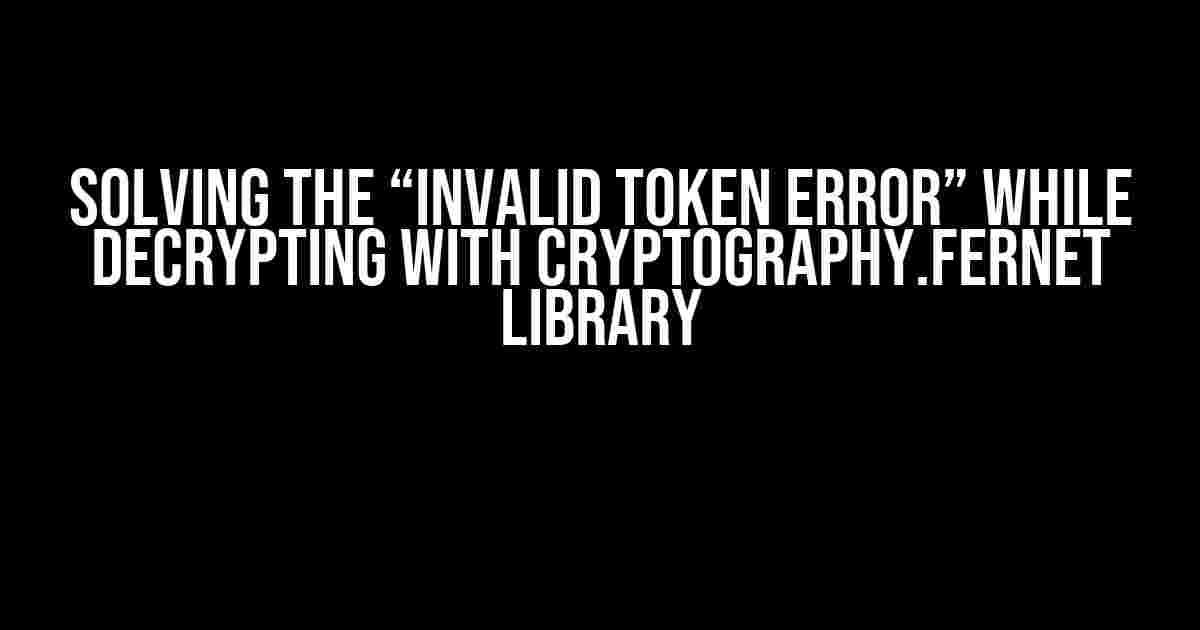Ah, the dreaded “Invalid Token Error” while decrypting with the cryptography.fernet library. You’re not alone, friend! Many of us have been there, staring at the screen, wondering what went wrong. But fear not, for today we’ll dive into the depths of Fernet tokens and explore the most common culprits behind this pesky error. By the end of this article, you’ll be equipped with the knowledge to tackle this issue head-on and decrypt your data with confidence!
What is Fernet and Why Do We Use It?
Fernet is a secure token-based authentication and encryption mechanism provided by the cryptography library in Python. It’s widely used for encrypting and decrypting sensitive data, such as API keys, passwords, and other confidential information. Fernet tokens are URL-safe, compact, and incredibly secure, making them an ideal choice for many applications.
So, What’s This “Invalid Token Error” About?
When you attempt to decrypt a Fernet token that’s been tampered with, corrupted, or simply invalid, you’ll encounter this error. It’s a security feature, really! Fernet is telling you that something’s fishy, and it’s not going to let you decrypt potentially malicious data. But why does this happen, you ask?
Common Causes of the “Invalid Token Error”
Let’s explore the most common culprits behind this error:
- Token Corruption: During transmission or storage, the token might get corrupted, leading to an invalid token error.
- Token Tampering: A malicious actor might attempt to modify the token, causing it to become invalid.
- Token Expiration: Fernet tokens have a limited lifespan. If the token has expired, decryption will fail.
- Key Mismatch: Using the wrong key to decrypt the token will result in an invalid token error.
- Token Format Issues: Fernet tokens have a specific format. If the token is malformed or doesn’t conform to the expected format, decryption will fail.
Troubleshooting the “Invalid Token Error”
Now that we’ve identified the common causes, let’s walk through some troubleshooting steps to resolve the issue:
Step 1: Verify Token Integrity
Check if the token has been corrupted during transmission or storage. Try regenerating the token and re-decrypting to rule out any corruption issues.
Step 2: Validate Token Format
Ensure the token conforms to the expected format. Fernet tokens typically consist of three parts: URL-safe base64-encoded version, timestamp, and ciphertext. Check that the token has the correct number of parts and that each part is correctly formatted.
import base64
token_parts = token.split('.')
if len(token_parts) != 3:
print("Invalid token format!")
exit()
version, timestamp, ciphertext = token_parts
if not (version and timestamp and ciphertext):
print("Invalid token format!")
exit()
Step 3: Check Token Expiration
Verify that the token hasn’t expired. Fernet tokens have a limited lifespan, so ensure the token is still valid.
import time
from cryptography.fernet import Fernet
fernet = Fernet(key)
try:
fernet.extract_timestamp(token)
except Exception as e:
print("Token has expired!")
exit()
Step 4: Verify Key Mismatch
Double-check that you’re using the correct key to decrypt the token. Remember, Fernet tokens are sensitive to the key used for decryption.
import cryptography
fernet = cryptography.fernet.Fernet(key)
try:
decrypted_data = fernet.decrypt(token)
except cryptography.fernet.InvalidToken as e:
print("Key mismatch or invalid token!")
exit()
Best Practices to Avoid the “Invalid Token Error”
To minimize the likelihood of encountering the “Invalid Token Error”, follow these best practices:
| Best Practice | Description |
|---|---|
| Use a secure key | Generate a random, secret key and store it securely. |
| Store tokens securely | Use a secure storage mechanism, such as an encrypted database or a secure token store. |
| Handle token errors gracefully | Catch and handle token errors during decryption, rather than letting the application crash. |
| Implement token rotation | Periodically rotate tokens to minimize the impact of token exposure or expiration. |
| Use a token validation mechanism | Implement a mechanism to validate tokens before decryption, such as checking the token format and expiration. |
Conclusion
In conclusion, the “Invalid Token Error” while decrypting with the cryptography.fernet library can be a frustrating experience, but by following the troubleshooting steps and best practices outlined in this article, you’ll be well-equipped to resolve the issue and ensure the secure encryption and decryption of your data.
Remember, Fernet tokens are a powerful tool for securing sensitive data, but they require careful handling and management. By being proactive and implementing the right strategies, you can avoid the “Invalid Token Error” and ensure the integrity of your application.
So, the next time you encounter this error, don’t panic! Take a deep breath, follow the steps outlined above, and you’ll be decrypting your data in no time.
Happy coding, and stay secure!
Frequently Asked Question
Stuck with the frustrating “invalid token error” while decrypting using the cryptography.fernet library? Don’t worry, we’ve got you covered! Here are some frequently asked questions and answers to help you troubleshoot and resolve the issue:
Q: What is the “invalid token error” in cryptography.fernet, and what are its common causes?
The “invalid token error” in cryptography.fernet typically occurs when the Fernet token is malformed, tampered with, or not generated correctly. Common causes include incorrect key usage, token manipulation, or corruption during storage or transmission. Ensure that you’re using the correct key, and the token is generated and stored properly.
Q: How can I verify that my Fernet key is correct and properly generated?
To verify your Fernet key, ensure that you’re using a URL-safe base64-encoded 32-byte key. You can generate a new key using the cryptography.fernet.Fernet.generate_key() method. Additionally, double-check that you’re using the same key for encryption and decryption. If you’re still unsure, try regenerating a new key and testing it.
Q: Can I use the same Fernet key for both encryption and decryption, or do I need separate keys?
You should use the same Fernet key for both encryption and decryption. The key is used to encrypt and decrypt the data, so using a different key for decryption will result in an “invalid token error”. Make sure to store the key securely and use it consistently for both encryption and decryption operations.
Q: What are some common mistakes that can lead to an “invalid token error” when using cryptography.fernet?
Some common mistakes that can lead to an “invalid token error” include using an incorrect or malformed key, manipulating the encrypted token, storing the token incorrectly, or using a different key for decryption. Additionally, ensure that you’re using the correct Fernet instance for decryption, and that the token is not expired or tampered with.
Q: Are there any additional steps I can take to troubleshoot and resolve the “invalid token error”?
To troubleshoot the “invalid token error”, try debugging your code, checking the token generation and storage, and verifying the key usage. You can also enable debug logging to get more detailed error messages. Additionally, ensure that you’re using the latest version of the cryptography.fernet library, and consider using a token validation mechanism to detect any token tampering or corruption.


